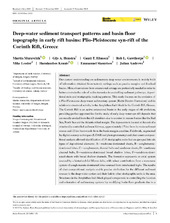| dc.contributor.author | Muravchik, Martin | |
| dc.contributor.author | Henstra, Gijs Allard | |
| dc.contributor.author | Eliassen, Gauti | |
| dc.contributor.author | Gawthorpe, Rob | |
| dc.contributor.author | Leeder, MR | |
| dc.contributor.author | Kranis, H | |
| dc.contributor.author | Skourtsos, E | |
| dc.contributor.author | Andrews, J. | |
| dc.date.accessioned | 2020-06-24T13:16:13Z | |
| dc.date.available | 2020-06-24T13:16:13Z | |
| dc.date.issued | 2019 | |
| dc.Published | Muravchik M, Henstra G A, Eliassen G, Gawthorpe R L, Leeder M, Kranis H, Skourtsos E, Andrews J. Deep-water sediment transport patterns and basin floor topography in early rift basins: Plio-Pleistocene syn-rift of the Corinth Rift, Greece. Basin Research. 2019 | eng |
| dc.identifier.issn | 1365-2117 | en_US |
| dc.identifier.issn | 0950-091X | en_US |
| dc.identifier.uri | https://hdl.handle.net/1956/22946 | |
| dc.description.abstract | Our current understanding on sedimentary deep‐water environments is mainly built of information obtained from tectonic settings such as passive margins and foreland basins. More observations from extensional settings are particularly needed in order to better constrain the role of active tectonics in controlling sediment pathways, depositional style and stratigraphic stacking patterns. This study focuses on the evolution of a Plio‐Pleistocene deep‐water sedimentary system (Rethi‐Dendro Formation) and its relation to structural activity in the Amphithea fault block in the Corinth Rift, Greece. The Corinth Rift is an active extensional basin in the early stages of rift evolution, providing perfect opportunities for the study of early deep‐water syn‐rift deposits that are usually eroded from the rift shoulders due to erosion in mature basins like the Red Sea, North Sea and the Atlantic rifted margin. The depocentre is located at the exit of a structurally controlled sediment fairway, approximately 15 km from its main sediment source and 12 km basinwards from the basin margin coastline. Fieldwork, augmented by digital outcrop techniques (LiDAR and photogrammetry) and clast‐count compositional analysis allowed identification of 16 stratigraphic units that are grouped into six types of depositional elements: A—mudstone‐dominated sheets, B—conglomerate‐dominated lobes, C—conglomerate channel belts and sandstone sheets, D—sandstone channel belts, E—sandstone‐dominated broad shallow lobes, F—sandstone‐dominated sheets with broad shallow channels. The formation represents an axial system sourced by a hinterland‐fed Mavro delta, with minor contributions from a transverse system of conglomerate‐dominated lobes sourced from intrabasinal highs. The results of clast compositional analysis enable precise attribution for the different sediment sources to the deep‐water system and their link to other stratigraphic units in the area. Structures in the Amphithea fault block played a major role in controlling the location and orientation of sedimentary systems by modifying basin‐floor gradients due to a combination of hangingwall tilt, displacement of faults internal to the depocentre and folding on top of blind growing faults. Fault activity also promoted large‐scale subaqueous landslides and eventual uplift of the whole fault block. | en_US |
| dc.language.iso | eng | eng |
| dc.publisher | Wiley | en_US |
| dc.rights | Attribution CC BY | eng |
| dc.rights.uri | http://creativecommons.org/licenses/by/4.0/ | eng |
| dc.title | Deep-water sediment transport patterns and basin floortopography in early rift basins: Plio-Pleistocene syn-rift of theCorinth Rift, Greece | en_US |
| dc.type | Peer reviewed | |
| dc.type | Journal article | |
| dc.date.updated | 2020-01-04T14:35:52Z | |
| dc.description.version | publishedVersion | en_US |
| dc.rights.holder | Copyright 2019 The Authors | en_US |
| dc.identifier.doi | https://doi.org/10.1111/bre.12423 | |
| dc.identifier.cristin | 1766265 | |
| dc.source.journal | Basin Research | |
| dc.relation.project | Norges forskningsråd: 255229 | |
| dc.relation.project | VISTA: VISTA | |

